19. THE SETTLING IN OF THE COLD WAR

A SUPPOSED SHIFT IN THE COLD WAR
CONTENTS
 The European unity movement grows The European unity movement grows
 The Congo Crisis The Congo Crisis
 The Bi-Polar World in Transition The Bi-Polar World in Transition
 De Gaulle steps forward ... demanding a De Gaulle steps forward ... demanding a
new French Fifth Republic
The textual material on page below is drawn directly from my work
A Moral History of Western Society © 2024, Volume Two, pages 282-290.
THE EUROPEAN UNITY MOVEMENT GROWS |
|
The Treaty of Rome founding the European "Common Market" (1957)
On 25 March 1957, representatives of Belgium, France, Italy,
Luxembourg, the Netherlands, and West Germany formally signed at Rome a
new treaty, proposing to unite in numerous ways the economies of these
six participating European nations. With the signing of this
treaty, the European Economic Community (EEC) or "European Common
Market" was scheduled to come into existence on 1 January 1958.
This was all part of the mood to create something of a United States of
Europe, begun with the Schuman Plan which led to the creation of the
ECSC in 1952, and the Pleven Plan, which attempted to unify the
military of the same nations … but which failed when the French
National Assembly would not ratify the EDC treaty.
The latter failure however did not discourage those still seeking to
unify a post-World-War-Two Europe. Under no circumstances was a
politically vulnerable national spirit to be allowed to push the
Europeans into another such war. Internationalism – not
nationalism – was to be the new spirit directing European development.
As a result of a European conference at Messina in 1955, Belgian
politician Paul-Henri Spaak was directed to come up with a plan at
least to unify quite broadly the economies of West Europe into a Common
Market. Spaak's Plan then led to a conference the following year
… in which some of the ECSC's institutions and that of the European
Court of Justice would be used to form just such a Common Market
…although it was decided to keep the matter of vital atomic energy
development separate from the rest of the economic realm. Thus
two separate organizations, Euratom and the EEC were designed to move
things forward.
Thus it was that at Rome in March of 1957, the Treaty bringing both
organizations into being was signed … and then submitted to the
parliaments of the various participants for ratification. This
time ratification was done quickly by all participants. Now the
trade in European products could move without any tariff restrictions
(eventually the move of labor across national borders would also take
place as part of the deal).
Britain tries to go its own way
But Britain was not one of those EEC participants … preferring to stay
focused on its economic relations with its Commonwealth partners, to
continue to give its farmers trade protection … and a sentiment that
Britain did best when working with America. And as an alternative
to the EEC, Britain instead in 1959 helped put together its own
European trade organization, the European Free Trade Area (EFTA),
designed to promote trade among the members … without having to impose
a single or unified tariff such as was central to the EEC
program. EFTA was thus designed to move forward in mutual
economic support the European nations of Britain, Austria, Denmark,
Norway, Portugal, Sweden and Switzerland (and eventually
Finland). However, it soon proved that the amount of trade
among those nations was not very substantial. Thus EFTA came to
be a rather insignificant organization.
Finally, in 1961, seeing France and Germany develop economically vastly
more rapidly than Britain, British Prime Minister Harold Macmillan made
the decision to begin the process of gaining British entry into the
EEC. But in 1963 a quite anti-Anglo-Saxon de Gaulle (who rather
despised both Britain and America) vetoed the British
application. And there was nothing further that could be done on
the matter … as long as de Gaulle remained France's leader.
|
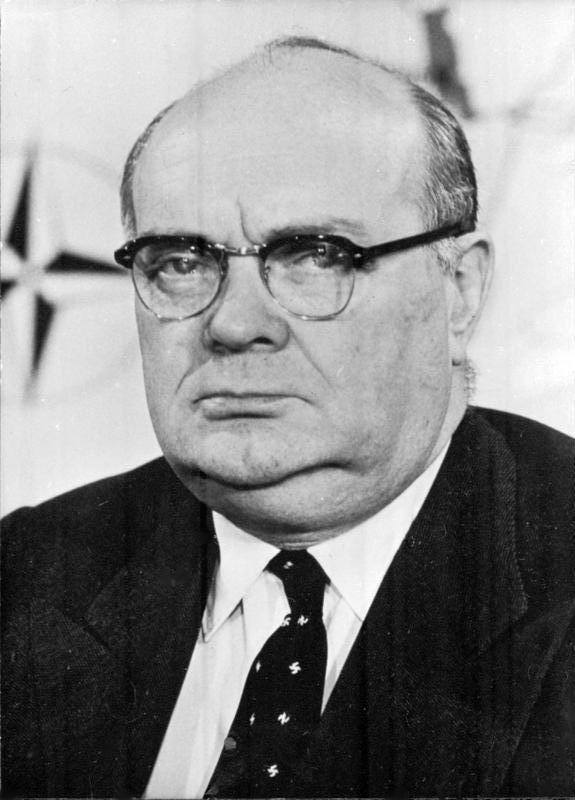
Paul-Henri Spaak - led the committee designing the two treaty organizations
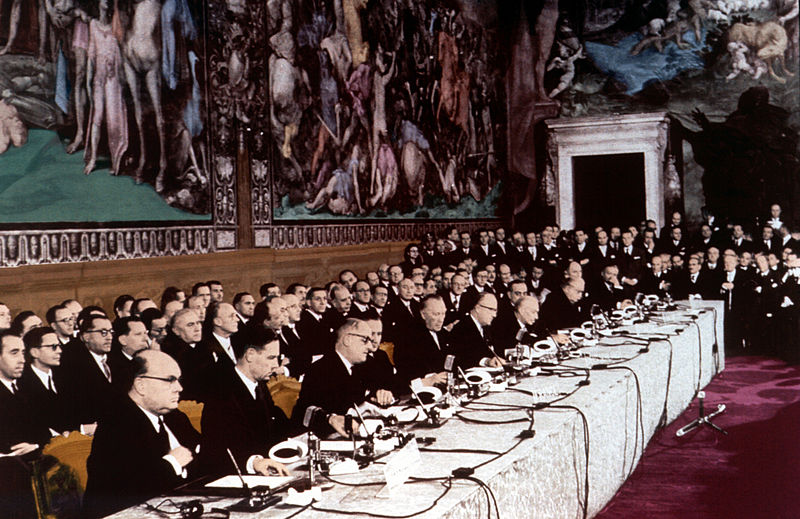
The signing of the Treaty of Rome (March 25, 1957) by representatives of France, Italy, West Germany, Netherlands, Luxembourg and Belgium
America is highly supportive of "collective security" ...
uniting West Europe closely militarily with America and Canada
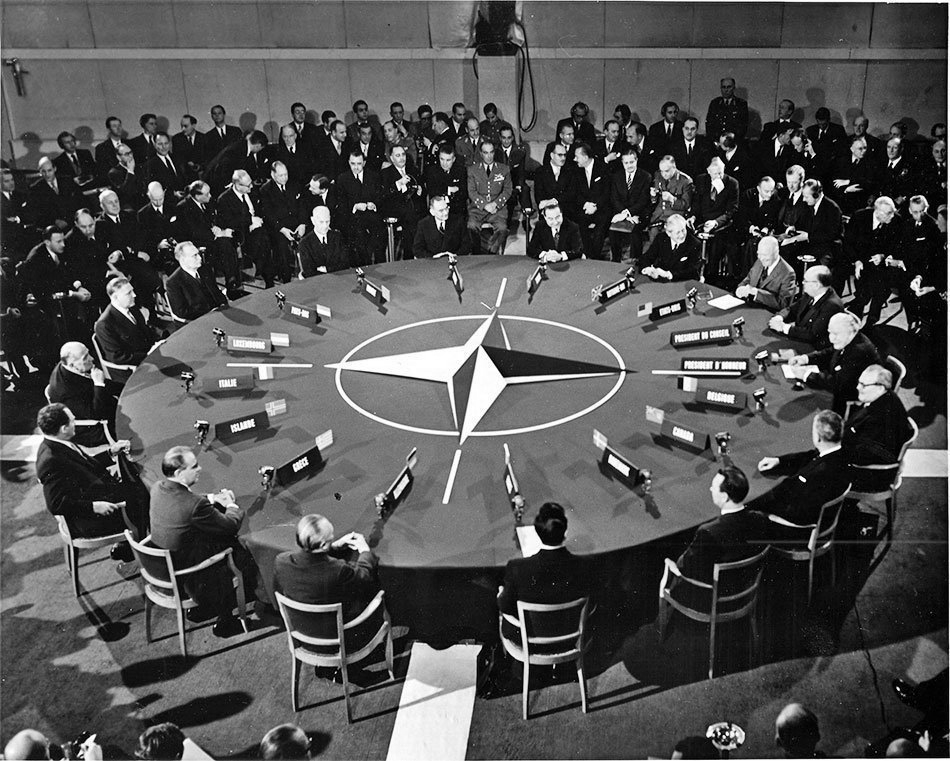
December 1957 - Eisenhower addressing NATO at a Paris Summit Meeting
|
Intense personal political rivalry
Another major crisis to keep deeply the world's attention took place at
about the same time in Sub-Saharan Africa … when the Belgians finally
gave over their Congo colony in June of 1960 to a hopeful coalition of
local Congolese leaders, supposedly constituting the leadership team of
a new Republic of the Congo. But with the departure of the
Belgians, Congo society immediately broke down into a number of
contending political groups ... principally between the new Congo
President, Joseph Kasavubu, the new Prime Minister, Patrice Lumumba,
and Moïse Tshombe, the leader of the secessionist Katanga
Province. The Katanga Province was where most of the vast mineral
wealth of the Congo was located. And Tshombe's desire to have his
Katanga go its own way as an independent country in Africa was seen as
a clever way designed by the Belgians to continue to hold on to their
key economic interests in their former colony. Also another
smaller but also mineral-rich province, Kasai, was similarly attempting
to set itself up as an independent state. And ultimately there
was the staff of the new Congolese army, anxious to play a key role in
the Congo's political development. Things got very messy,
very quickly.
The competition for power that developed among these leaders was of
course personal, but also ideological, economic and ultimately (and
most cruelly) tribal ... leading to an outbreak of ethnic cleansing
undertaken by the Bakongo and the Baluba tribesmen (especially the
Baluba of Kasai who were slaughtered by the thousands) ... and full
revolt of sections of the new Congolese army.
Belgian Whites also found themselves caught in the middle of the strife
... with the Belgians themselves accused of playing the Congolese
contentions to their own economic and political advantage.
The U.N. intervenes
In mid-July of 1960 the U.N. Security Council approved a U.N.
peacekeeping force to place itself in the Congo to try to stabilize the
quickly collapsing political situation there. Lumumba was hoping
that these U.N. troops would help him put down the secessionist
movements of the Kasai and Katanga provinces. But the U.N.
Secretary-General Dag Hammarskjöld insisted that they had no
authorization to serve in this capacity. So Lumumba turned to
America for support ... but found Eisenhower reluctant to put America
to such service, especially to a known "Socialist." Lumumba thus
did the one thing designed to make America crazy: turn to the
Soviets for assistance. Khrushchev was more than happy to help
out, immediately sending some 1000 military "advisers" to the Congo to
help Lumumba secure the unity of the Congo.
America now saw the Congo as going in the direction of Cuba: taking aid
from the Soviets and thus joining the Soviet camp … and in the eyes of
America also becoming "Communist" in the process.
Mobutu takes action
Then in early September Colonel Mobutu Sese Seko seized control and had
the feuding Kasavubu and Lumumba removed from office – and a new
council put in their place to try to bring things back under control …
with Mobutu actually dominating things politically from behind the
scenes. Now began the very unsteady process of trying to get the
various leaders to work together – minus Lumumba, who was arrested
(September). Lumumba then escaped to the Eastern Congo to set up
his own government at Stanleyville. But he was captured in
December by Mobutu's forces. Lumumba’s fate now stirred considerable
action in the U.N. … and between America and the Soviets. Then in
early 1961 Lumumba was sent to Katanga … where he was immediately but
quietly executed (January 1961) by Tshombe’s troops. When news of
Lumumba's execution finally emerged, the international outrage at this
point was huge. It also inspired the rapid spread of the
pro-Lumumba Simba Rebellion across the Eastern Congo.
The U.N. presses for a solution
Now Hammarskjöld attempted to undertake some personal diplomacy
(mid-September 1961) to get the civil war to come to a halt ... but in
flying to Africa, his plane crashed – with all aboard killed.
Likewise, the attack on Irish U.N. troops (November 1960) and the
killing of 13 Italian U.N. pilots a year later intensified the
international call for someone or something to bring the crisis to a
close.
More talks with Tshombe to bring his Katanga Province back into the
Congo Republic went back and forth during the next year (1962) ...
resulting in little real progress. Thus U.N. troops (20,000 at
this point) became more aggressive in their move against Tshombe ...
and in early 1963 Tshombe was forced to give up his independence
movement.
Finally getting things settled down
A new constitution was drafted and approved the following year ... and
Tshombe himself was called on to be the new Prime Minister! This
in turn sparked new tribal and political factional rebellions ... and a
new "People’s Republic of the Congo" was declared by leftist rebels –
quickly recognized and then supported by the Soviets, by Mao’s Chinese
Communists, and by Castro’s Cubans.
At this point the Cold War was in full swing ... with America
supporting the government of Tshombe and his military under Mobutu –
also aided by Belgian troops and a large group of White mercenary
troops.
Finally, in late 1964, a Simba rebellion in the Eastern Congo was
finally broken by the Belgian troops – who were then accused of
"neo-colonialism" by leftists everywhere. But it settled the
crisis down considerably.
However, growing tensions between Kasavubu and Tshombe created such a
political stalemate that once again Mobutu was moved to take control
(November 1965) ... and over the next years bring all governmental
powers into his own hands. He would continue to govern the Congo
(the Congo undergoing a name change in 1971 as "Zaire") until his death
in 1997!
THE BI-POLAR WORLD IN TRANSITION |
|
Eisenhower's People to People (1956)
Although a military man, Eisenhower – like most Americans (and others)
at the time – understood the Cold War to be fought not on a military
battlefield but instead a war fought in the minds of men and women in
the realm of ideas … ideas involving economic assistance programs,
educational programs, media presentation (he was a huge supporter of
Radio Free Europe) … and ultimately simply the personal exchange of
ideas by Americans with others of the world around him
Thus it was that in 1955 Eisenhower organized a "People to People"
conference to look at the idea of such personal exchange … and the
following year announced the actual establishment of a new government
program of that same name operating under the United States Information
Agency,1 given the task of connecting ordinary American citizens
with people overseas … connecting them through sporting events, musical
concerts, theatrical tours, "sister-cities" twinning … and even just by
way of individuals writing to each other as pen-pals. And after
Eisenhower himself suffered a heart attack, he expanded it to include
medical service abroad. Backing this program over the years were
major American leaders in all forms of social activities (from the
actor Bob Hope, to the Peanuts cartoonist Charles Schulz, to Walt
Disney and many others)!
This was very indicative of the American mindset of the times … shaped
by America's original or founding Puritan (Protestant Christian)
mindset, one that expected society to be built on the faithful service
of its active citizens … not on the commands coming from a ruling class
or organization of some form or other. This traditional Christian
mindset formed the foundations of the idea of "democracy" that America
was so eager to bring to the world.
But as we have already noted, this American mindset was not something
found commonly in the larger world. And there was nothing
instinctive about such a mindset. Quite importantly, Eisenhower was
correct in understanding that this would have to be taught to the
larger world … not brought to them by the force of arms.
Unfortunately, this critically important understanding of the social
dynamics of the larger world would be missing to most Americans, who –
having never known any other world than their own – just supposed that
the world "out there" was by all natural instincts ready to become like
them … only if freed from a tyrannical social order preventing them
from developing along these "Christian" (at this point actually quite
"Humanist") lines. Thus having a strong tendency to go down this
Idealistic path, confusion and serious political-diplomatic problems
would soon result for the rising American power.
1But
before leaving office in 1961 Eisenhower saw to it that the
People-to-People Program was privatized as a non-profit organization,
overseen by a Board of Directors located not in DC but in Missouri!

Eisenhower promoting his People to People Program - 1957
|
Sputnik
In October of 1957, Americans woke up to the shocking news that the
Soviets had launched into orbit around the earth the world's first
man-made satellite, the Sputnik. This was a double shock to Americans
because it meant not only that the Soviets beat America in this
critically important part of the race to show the world which society –
Soviet or American – was more effective in advancing the realm of
technology. It also meant that America no longer had protection from a
nuclear attack – for certainly the rockets carrying Sputnik into orbit
could also send nuclear bombs to America.
This was also a surprise because Soviet missile tests leading to this
event had been conducted secretly (hiding the fact of the numerous
catastrophes that had previously occurred) … whereas American tests
were conducted publicly – and cautiously for fear of just such a public
disaster. And indeed there occurred just such a media-covered disaster
that same December … soon after the Soviets had launched yet another
satellite in November with a dog aboard (which lived only a short time
in space).
Americans were not sure whom to blame … but certainly someone was
responsible for this grand American failure. What Americans did not –
or could not – understand was that such rocketry was a very complex
matter in areas not quite so visible … areas in which America was quite
advanced in its technological development.
Nonetheless, Eisenhower, in mid-1958, gave the American public his
answer in setting up the National Aeronautics and Space Administration
(NASA) … emphasizing the fact that NASA was to focus on science – not
warfare – in its research. This helped some … but still left Americans
sensing their vulnerability to a Soviet nuclear attack.
|
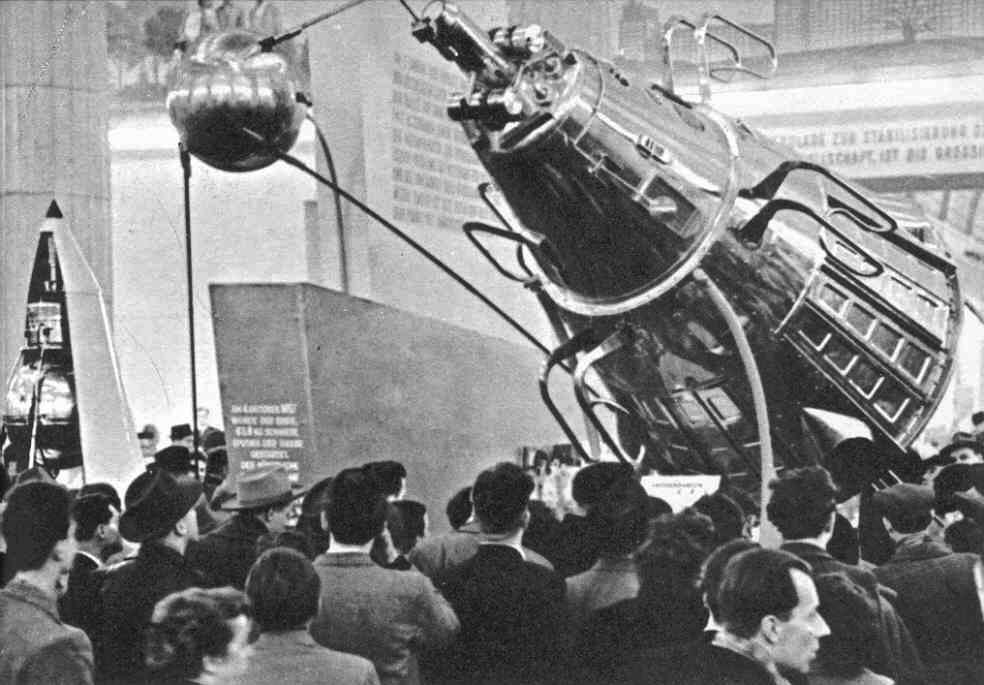
Models on display in East
Germany of the Sputnik (launched 1957) and the more elaborate Sputnik III
(launched 1958)
Sovfoto
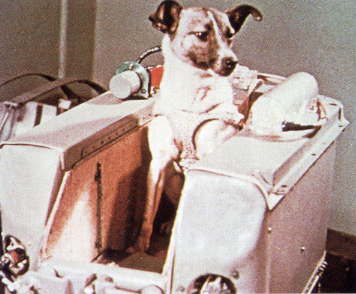
Laika - space dog, launched
into space November 3, 1957 on a one-way trip
|
"Peaceful coexistence"
Nonetheless, there was good cause to hope that both Americans and the
Soviets were going to be able to put the Cold War aside, at least the
portion that had the two superpowers aiming at each other militarily.
Seeing things now as a matter of competing ideas rather than guns,
there was some hope that the two sides could find that the realm of
ideas offered them the opportunity to work together in building the new
world … rather than standing in opposition to each other over every
matter.
Thus it was that in July of 1959 Vice President Nixon traveled to
Russia to support an American display of a typical American home at
Moscow's National Exhibition … and there also to conduct a friendly
debate (the famous "Kitchen Debate") with Khrushchev about the
differences in the lifestyle of the two countries. Then that same
September, Khrushchev returned the favor by coming to America to see
firsthand the "American Way" … from corn farming to the Hollywood movie
industry.
"Peaceful co-existence" seemed so completely the new international
mood, that an international conference to be held in Paris the coming
May (1960) was announced, one designed to bring Russia, America,
Britain and France together to investigate ways to improve world peace.
|
However efforts were made by a newly confident Khrushchev to demonstrate that he only wanted a greater sense of peace to reign in the world ... and invited
Vice President Nixon to visit Russia to see what the Russian world was truly like
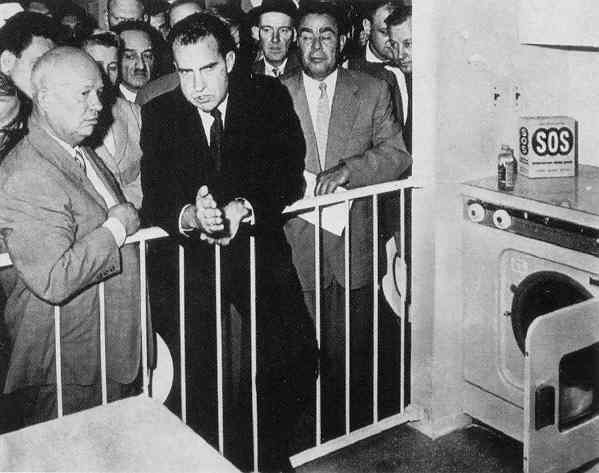
Khrushchev and Nixon having
their "kitchen debate" at the U.S. exhibition in Moscow - July 1959
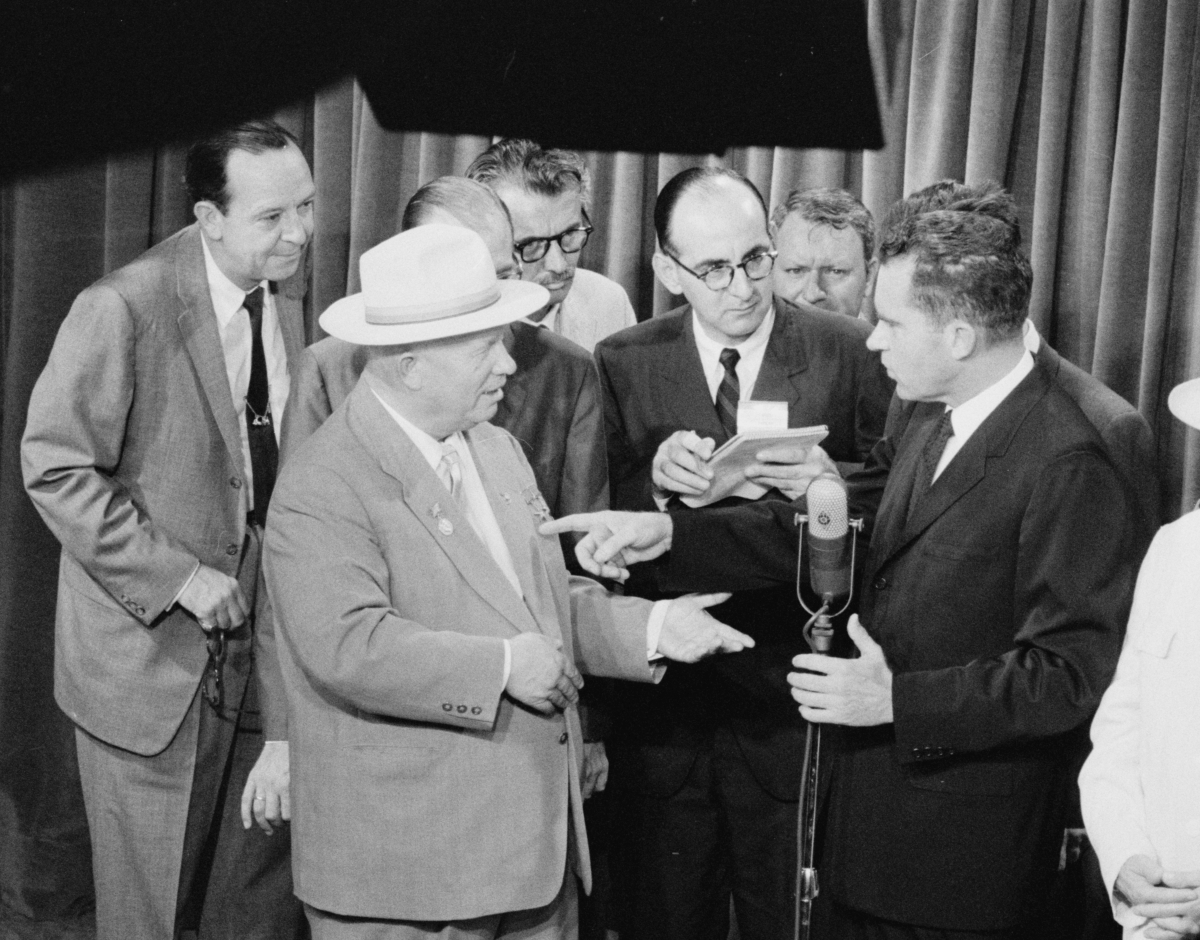
Khrushchev follows up a supposed "thaw" in the Cold War with his own visit to America
15-27 September 1959
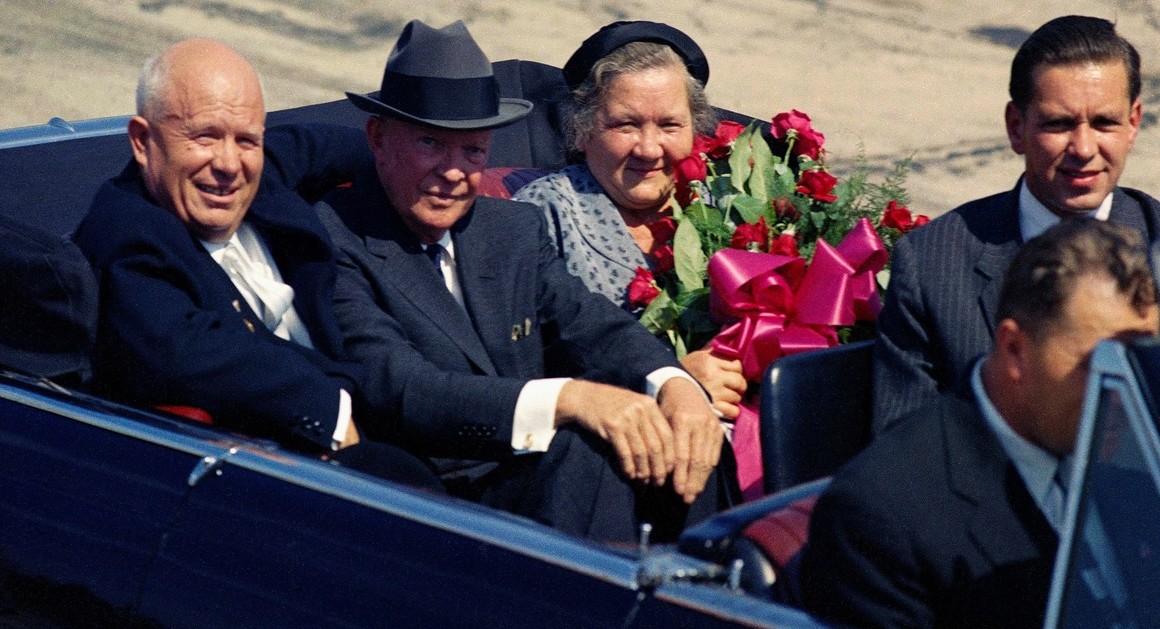
Here he is with Eisenhower riding in an open car
(still considered safe at the time)
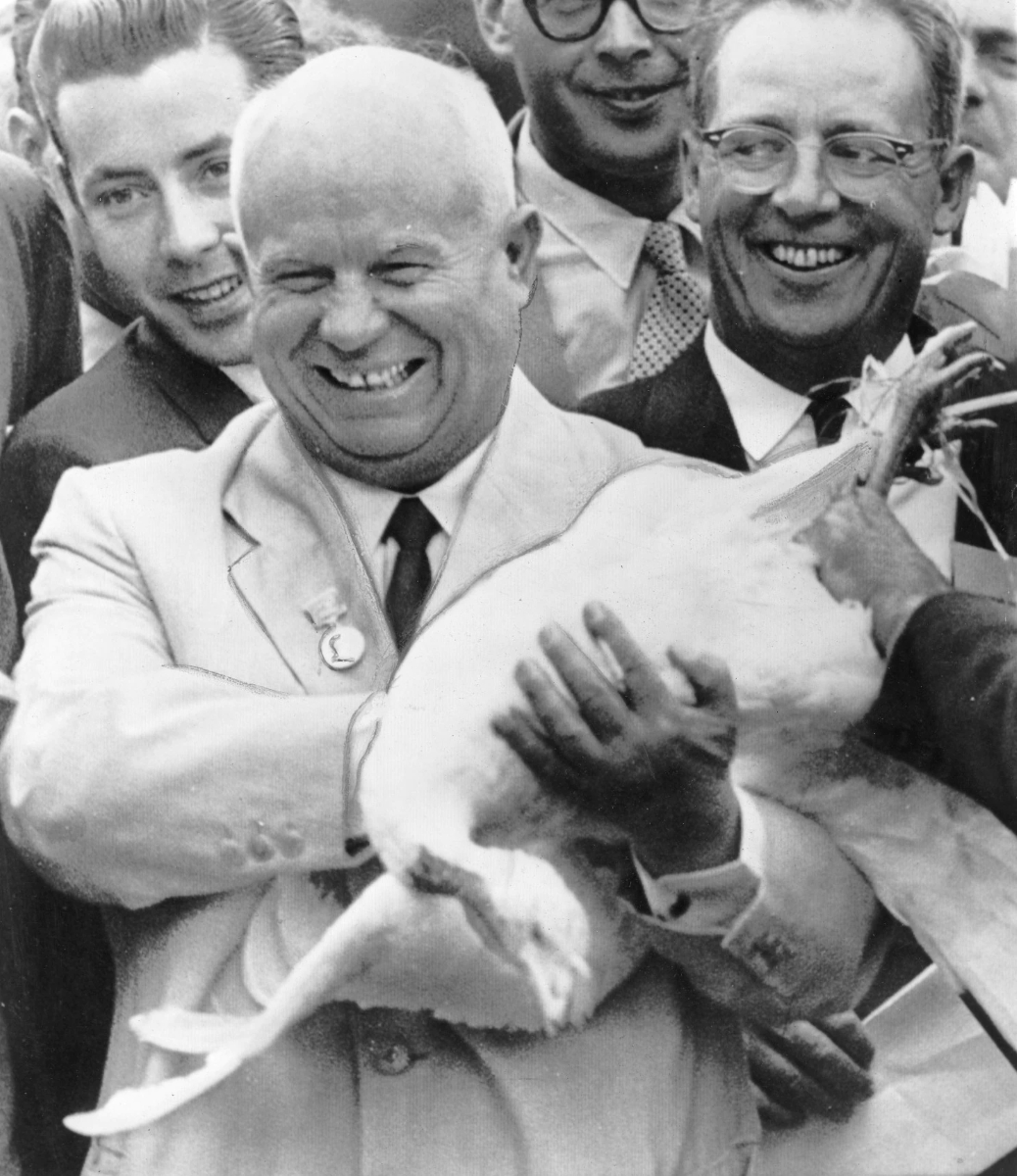
He visits American farms
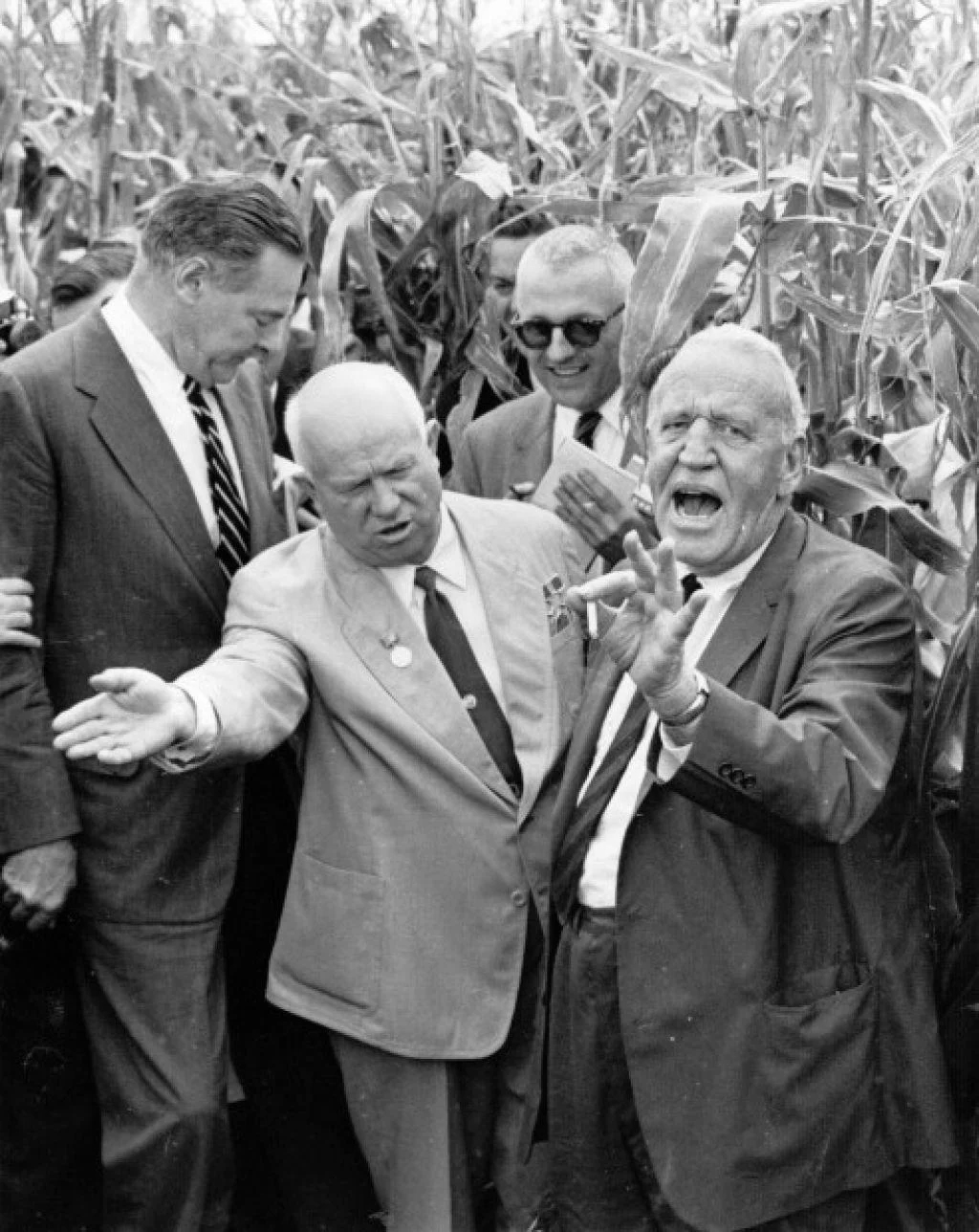
He even visits Hollywood
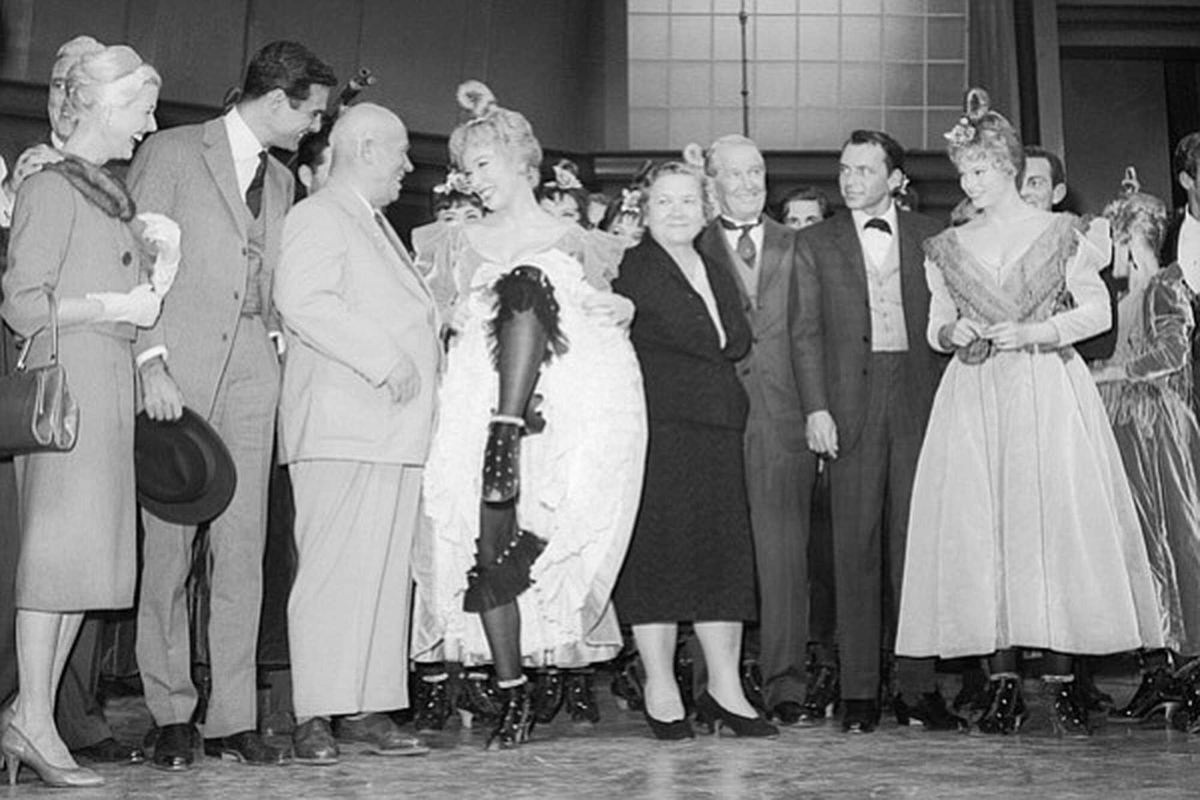
Here he is with Frank Sinatra ... and Shirley MacLaine during the filming of Can Can
And thus the world closes out the 1950s with the hope
that it has entered a new era of total peace
|
The U-2 incident
Then just two weeks before the scheduled Paris conference, the Russians
announced that they had shot down a very high-flying American U-2 plane
over Russian territory … spying on Russia, to be sure. Thus the mood
that was supposed to guide the upcoming conference was changed
considerably.
But the situation only worsened when Eisenhower, believing that neither
the plane nor its pilot could have survived the fall from such heights,
claimed that this was not a spy plane but instead only a weather plane
that had flown off course. But the pilot did survive – as well as
critical sections of the plane – both of which confirmed that Russia
had indeed brought down a spy plane.
At this point Khrushchev made as much as he could of the fact that he
had caught Eisenhower issuing what the president knew quite clearly to
be a lie. Thus Khrushchev announced that Russia would be withdrawing
from the upcoming conference.
"Peaceful coexistence" thus took a huge hit … as well as Eisenhower
politically. Sadly, the "era of good feelings" that Eisenhower was
hoping to leave behind as his presidential legacy was just not to be.
|
However ...
all the supposed "thaw" in
the Cold War seemed to come to an abrupt end on May 1st (1960) with the shooting down by
the Russians of an American U-2 spy plane over Soviet territory just two weeks prior to
a scheduled summit meeting in Paris.
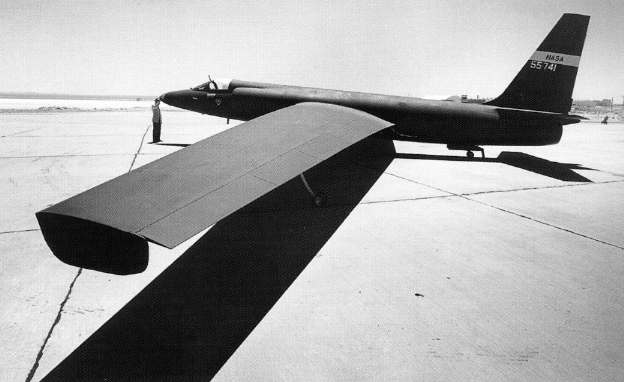
American U-2 spy plane with
its extra-long 80' wings. These wings allowed it to photograph
over enemy territory at a height of 13 miles.
But this was discovered
not to be adequate enough to avoid Soviet
anti-aircraft fire
when U-2 CIA pilot Gary Powers was shot down May 1,
1960.
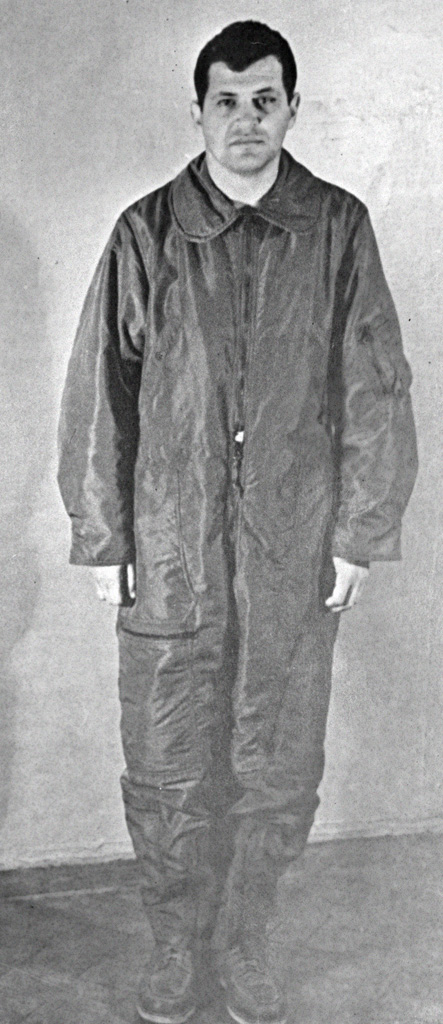
Soviet photo of captured
U-2 pilot Francis Gary Powers
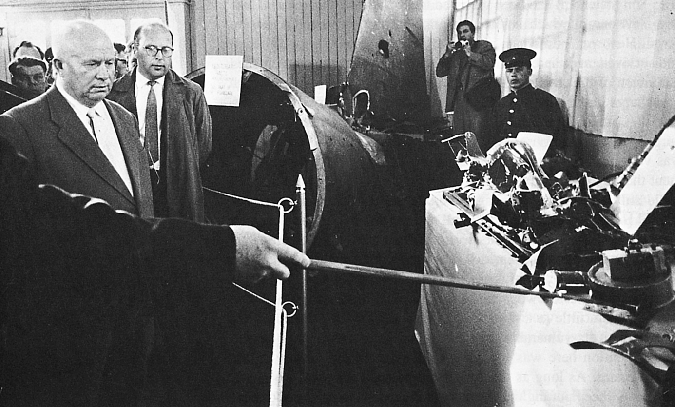 Khrushchev visits a display
of the U-2 wreckage
Khrushchev visits a display
of the U-2 wreckage
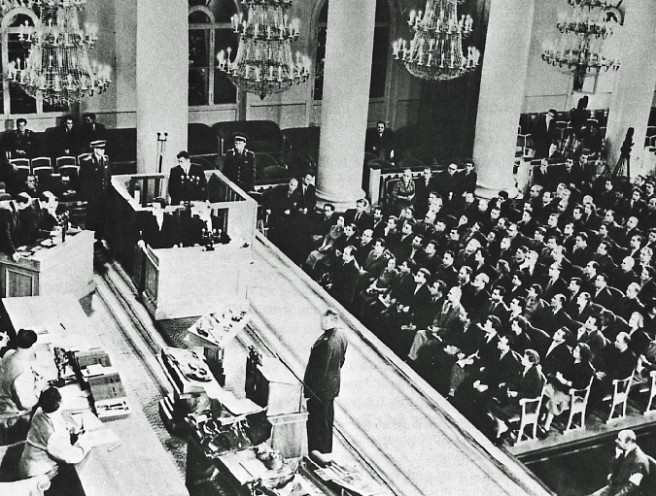 The Soviet trial of the U-2
pilot Powers - August 1960
The Soviet trial of the U-2
pilot Powers - August 1960
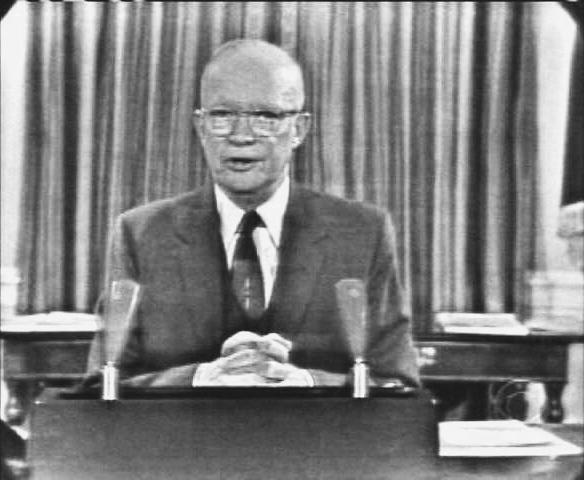 Eisenhower delivering a televised farewell address ... offering strategic advice
to Americans about the challenges standing before the country.
Eisenhower delivering a televised farewell address ... offering strategic advice
to Americans about the challenges standing before the country.
DE GAULLE STEPS FORWARD ... DEMANDING A NEW FRENCH FIFTH REPUBLIC |
|
The worsening situation in Algeria
By 1957, acts of terrorism were spreading not
only through Algeria but even France itself as Arab nationalists –
members of the FLN (Front de libération nationale) – and French
die-hards – members of the OAS (Organisation armée secrète) – fought
each other in the streets over the issue of Algerian independence.
Then when it looked as if the French government was interested in
negotiating a settlement with the FLN, on 13 May 1958, angry Algerian
French (soldiers and civilians) seized the government buildings in
Algiers and formed a new governing committee, headed by General Jacques
Massau – who the previous year had his paratroopers deliver a major
blow to the FLN. Infuriated over the idea that France was going
to abandon Algeria the way it did Vietnam, Massau now called on de
Gaulle to come out of retirement to save France. The expectation
was that de Gaulle would take the hard line against Arab nationalism
that the political leaders of the French 4th Republic seemed unwilling
or unable to assume.
In support of this move, French paratroopers took control in Corsica –
and rumors began to spread that they were readying themselves to take
control in Paris. A military coup in the heart of modern France
... how humiliating (and dangerous)! All eyes began to turn to de
Gaulle. Only he seemed to have the power to avert a horrible
national catastrophe. Thus it was that the French President René
Coty called on de Gaulle to take over as the Fourth Republic's prime
minister.
De Gaulle's Fifth Republic (1958)
De Gaulle was more than willing to answer the call to serve once again
as France's "savior" … but not unless he was granted six months of
emergency powers and unless a new constitution was drafted and approved
that would then give the French national executive the powers needed to
lead France. France seemed to have no other choice but to grant
de Gaulle his conditions. The French parliament voted its
approval of these terms … and thus at the beginning of June, de Gaulle
took over the French political process.
A new constitution was quickly drafted under the guidance of de
Gaulle's supporter Michel Debré, and in September (1958) was approved
in a national referendum by 78% of the French vote. In December
de Gaulle was elected President of the new French 5th Republic.
There were of course many issues confronting France at that time, and
de Gaulle set out to meet these challenges one by one (economic
recovery, relations with the Germans, with the Americans, with the
British, with France's African colonies). But definitely the
biggest challenge was Algeria ... and the general matter of African
independence. Algeria was not considered a colony and thus
handled differently than France's sub-Saharan African colonies … which
were immediately given the opportunity to go their way as newly
independent nations … although they would remain in a diplomatic union
with France as part of the French Community.2
Algerian independence (1961)
Now France and the world waited to see how de Gaulle was going to tackle the thorny problem of Algeria.
It soon became apparent that de Gaulle was leaning in the direction of
granting independence to Algeria. Consequently, the Algerian
French and sections of the French military felt betrayed – and became
bitter and rebellious … to the point of attempting a major military
coup against de Gaulle (April 1961). Numerous assassination
attempts were also made on de Gaulle. But de Gaulle remained in
tight control of the situation, crushing rebellions – even violently,
such as the bloody suppression of an Algerian uprising in Paris in
October of 1961 – of both Algerian nationalists on the one hand and the
very unhappy French Algerians (colons – also known as the pieds-noirs3)
on the other.
Finally, in March of 1962, de Gaulle's decision in favor of Algerian
independence was confirmed in the Evian Accords. In April, a
national referendum was held throughout France - with nearly 18 million
"yeses" to less than 3 million "nos." Then in July the Algerians
voted on the Accords, with nearly six million "yeses" and less than 17
thousand "nos."
It was official. Algeria was independent. And France could
move on. But so would a million pieds-noirs who abandoned their
homes and businesses in Algeria and headed for France, to try to start
up a new life there. And de Gaulle would have to face yet another
(very serious) assassination attempt on 22 August 1962.
2Only
the African colony of Guinée (Guinea) chose full independence at this
point, coming under the authoritarian rule of Ahmed Sékou Touré from
1958 until his death in 1984 – a time period in which he allied closely
with the Soviet Union … although in his last years he increasingly
looked to America and the West for economic assistance in the form of
investments in his country.
3"Black feet" … a
pejorative term long applied to the colons – the original source of the
term still something of a mystery … or at least under debate.
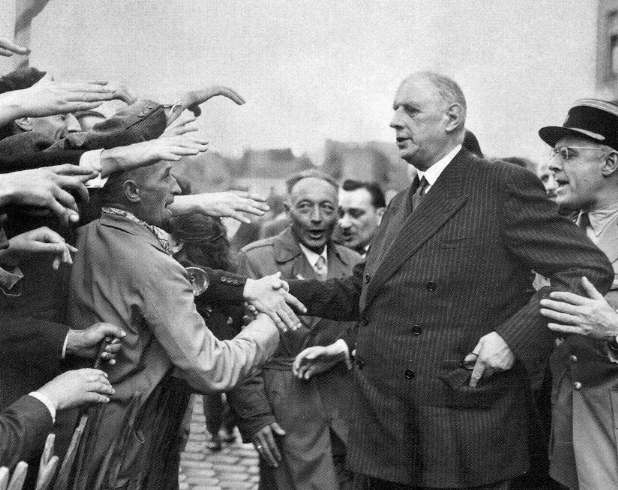
Charles De Gaulle takes over
French government in 1958 with the total stalemate
in French politics over the Algerian question
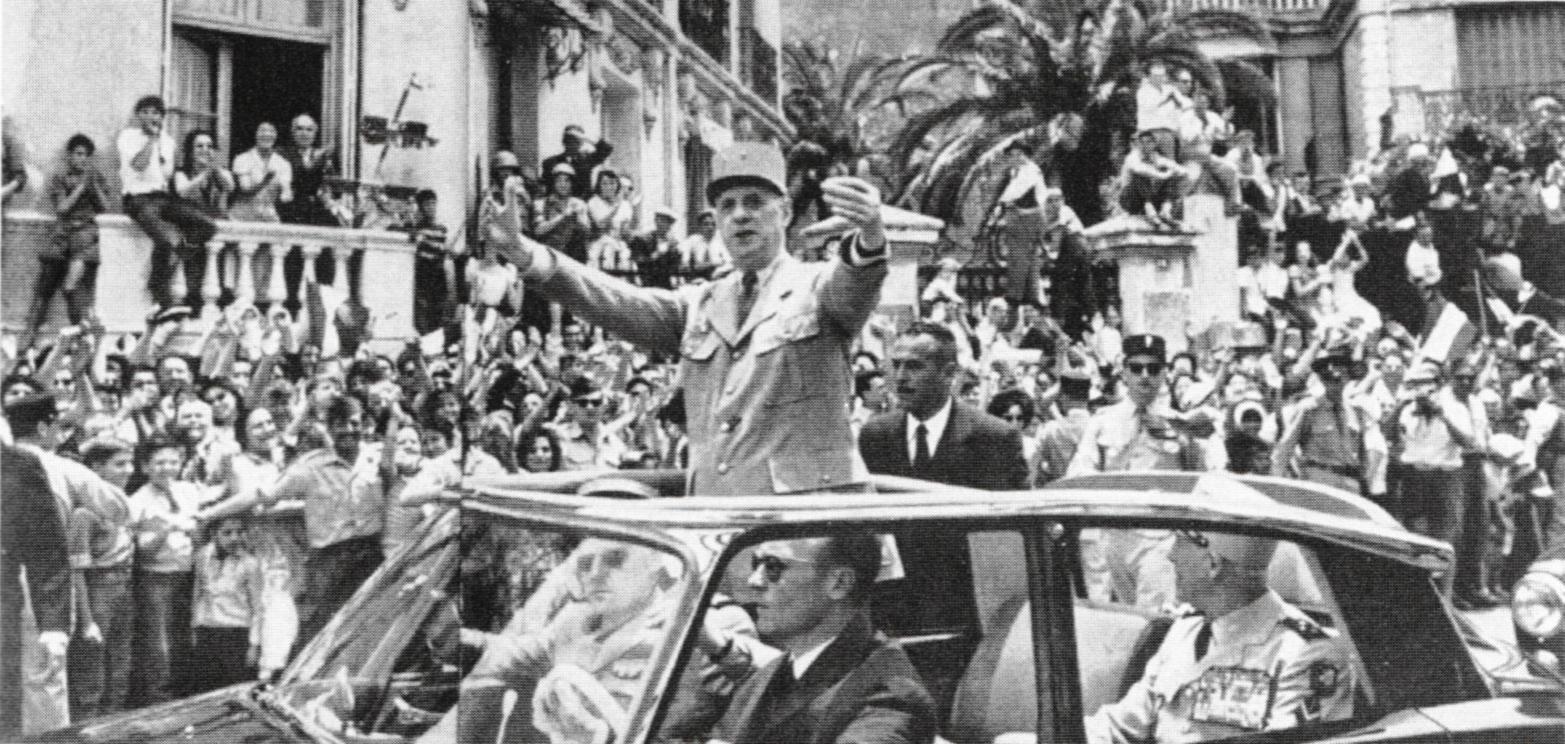
1958: General Charles
de Gaulle, being greeted in Algiers as the savior of the French in Algeria. The French Algerians were
certain that de Gaulle was going to keep Algeria in French hands ...
something,
however, that was not destined to happen.
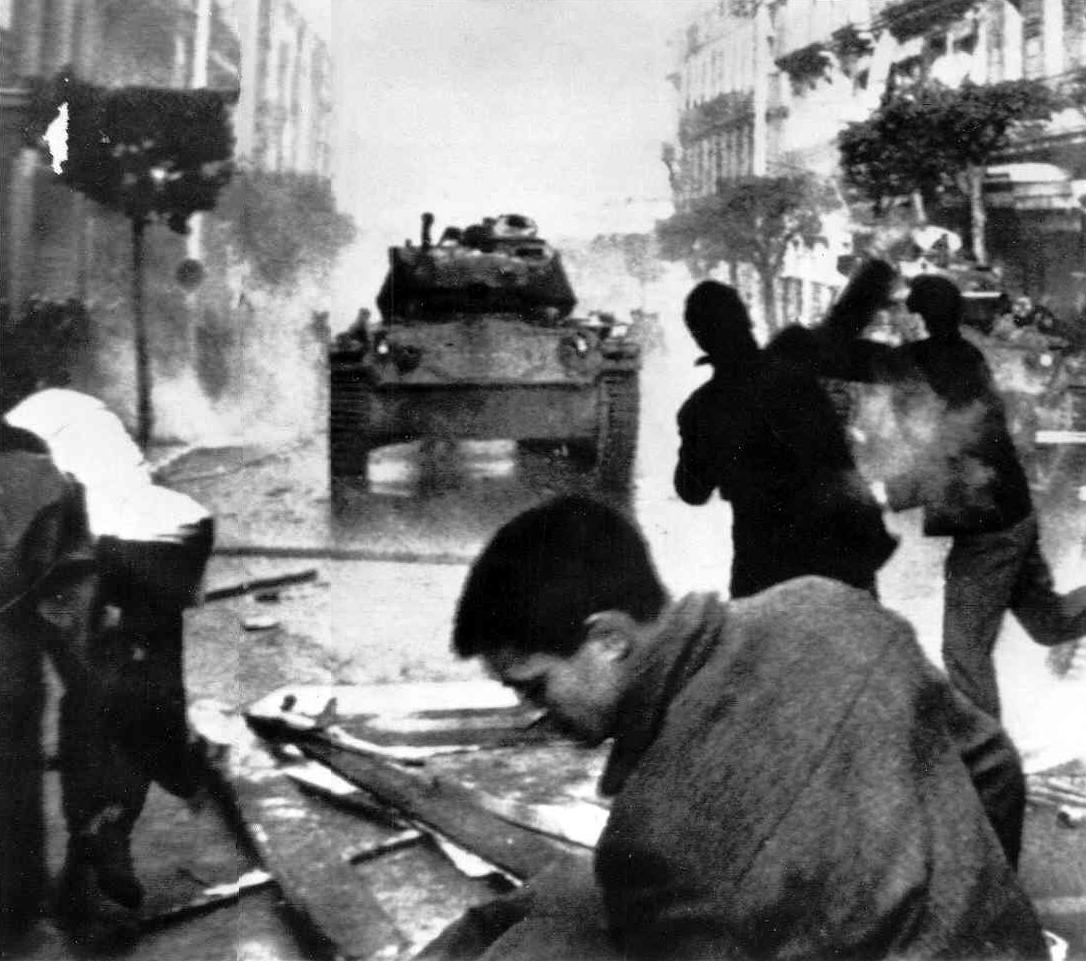
Algerian students engaged
in a street battle with French tanks - Algiers, December 1960
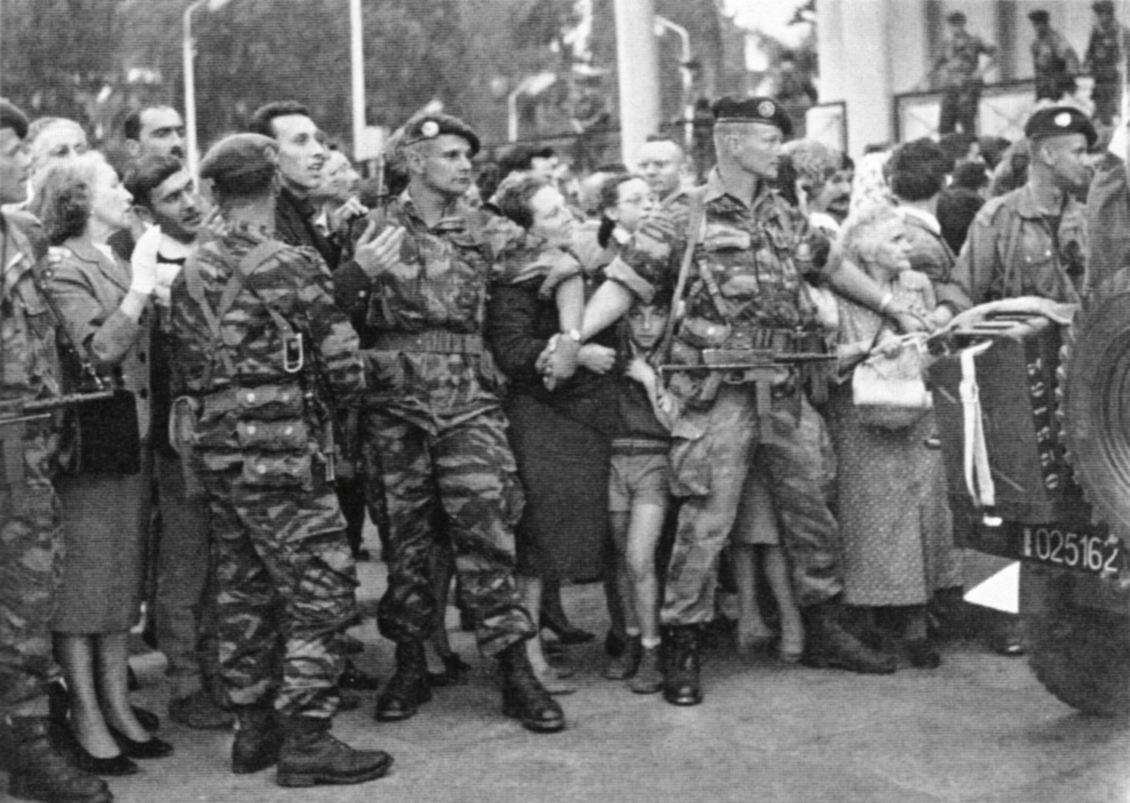
1961: Angry French
mass outside government headquarters in Algiers. They are listening to rebellious
French generals condemning de Gaulle's plan
to begin peace talks with the
Algerian (Arab) nationalists. The military was forced
to back down after four days of resistance.
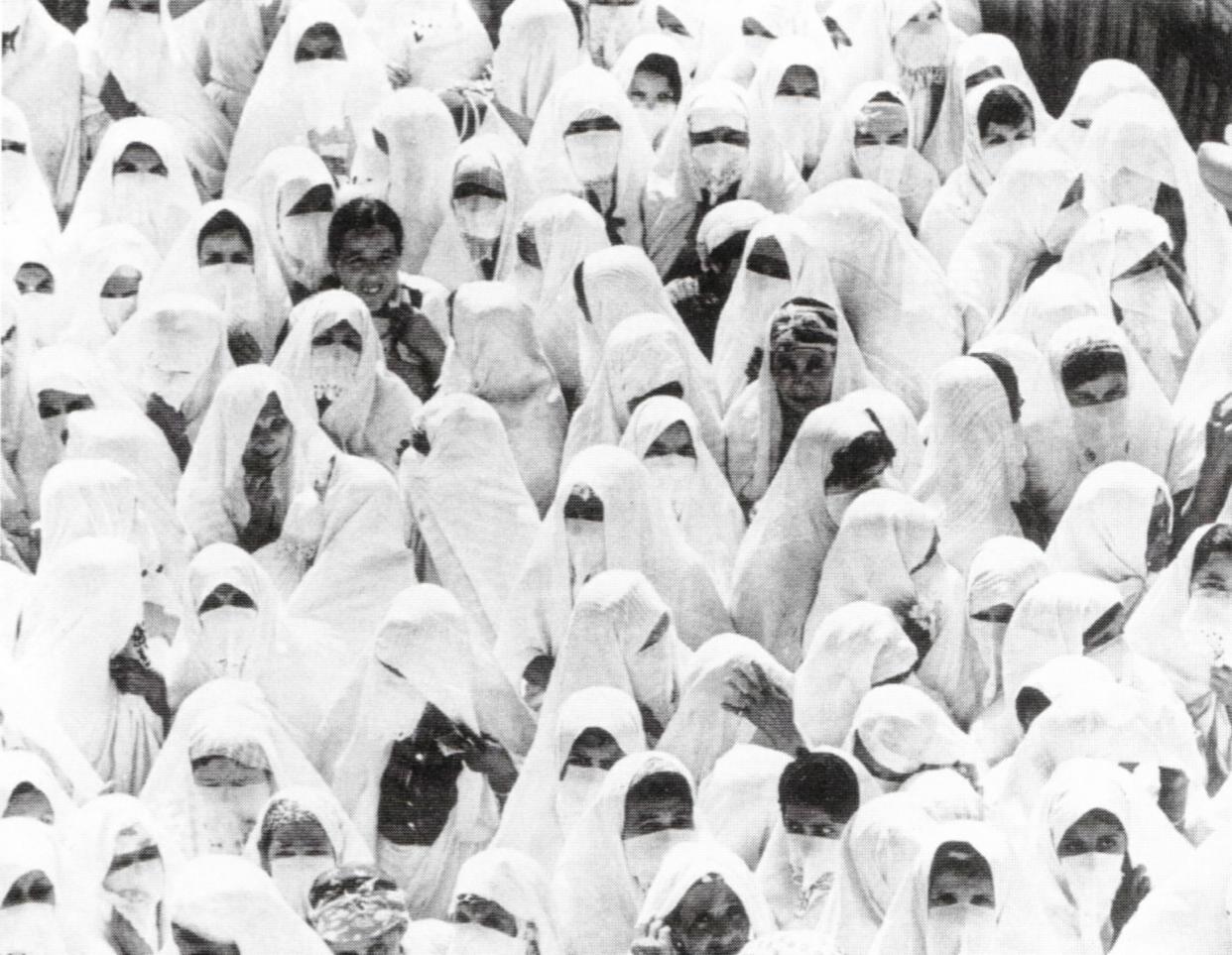
1962: Women gather
in Algiers to vote on the referendum on Algerian independence. Six million Algerians aid 'yes,'
Only 16,500 said 'no.' Approximately 1.4 million French (the pied
noir or "black feet") fled to France in fear of Arab Algerian
nationalism, leaving behind family homes,
farms and businesses.
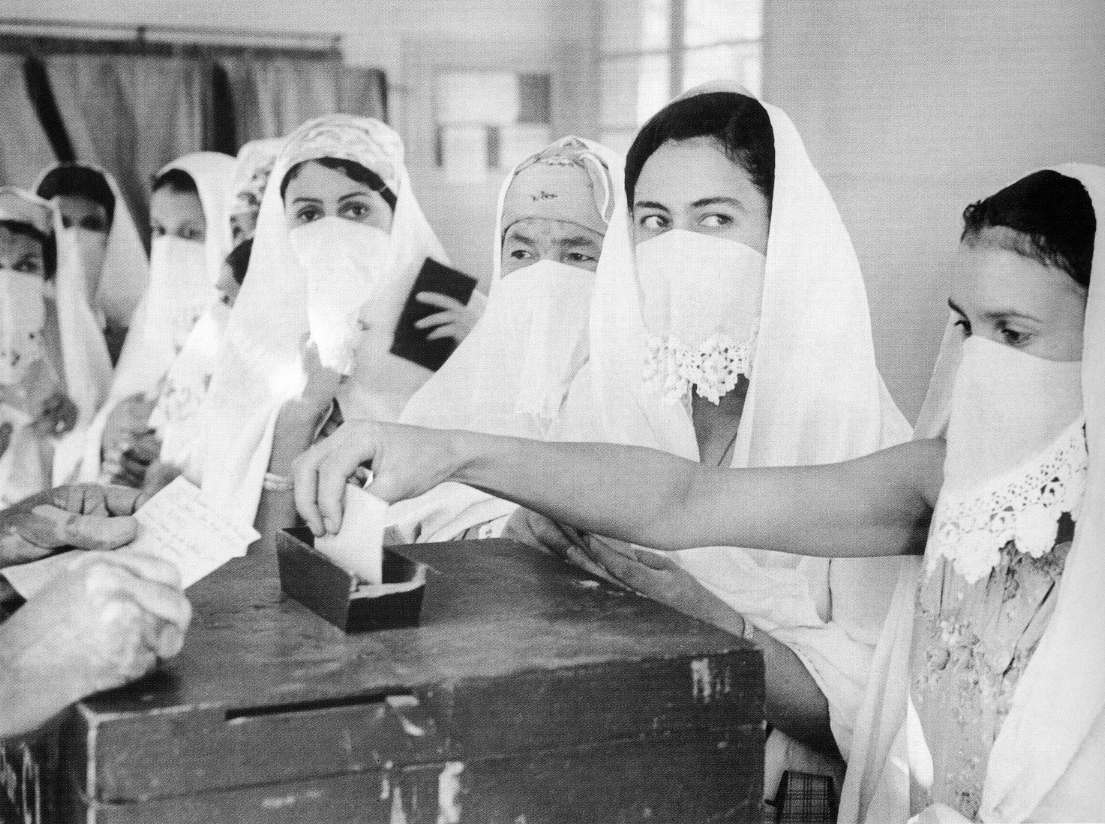
Algerian women voting on
the Algerian independence decision - 1962 (leading to the decision
of 1.4 million Europeans to leave Algeria)
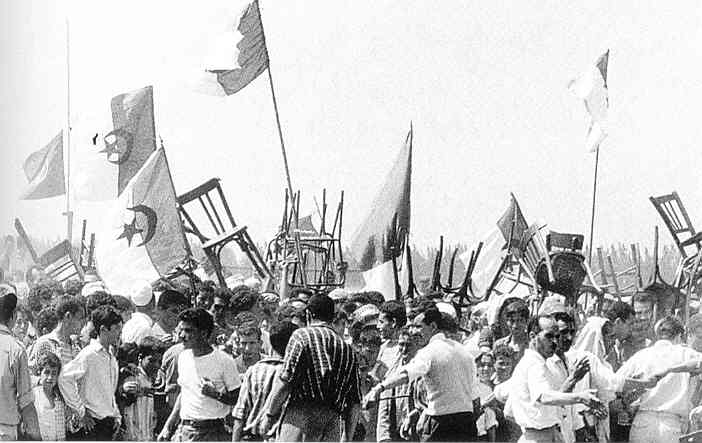 Algerian Arabs celebrate
independence from France after 132 years - March 1962
Algerian Arabs celebrate
independence from France after 132 years - March 1962

Go on to the next section: The Brief Kennedy (JFK) Era - 1961-1963
 Miles
H. Hodges Miles
H. Hodges
| | | |


 The European unity movement grows
The European unity movement grows
 The Bi-Polar World in Transition
The Bi-Polar World in Transition
 De Gaulle steps forward ... demanding a
De Gaulle steps forward ... demanding a























 Algerian Arabs celebrate
independence from France after 132 years - March 1962
Algerian Arabs celebrate
independence from France after 132 years - March 1962

